Canopy-Wind-Induced Pressure Fluctuations Drive Soil CO2 Transport in Forest Ecosystems
Abstract
1. Introduction
2. Materials and Methods
2.1. Study Site
2.2. Experimental Setup
2.3. Data Analysis
3. Results
3.1. Changes in Wind Speed, Air Pressure, and Soil CO2 Concentration
3.2. Response Relationship Between Wind Speeds Above and Below the Canopy
3.3. Response of Soil CO2 Concentration in the Vertical Soil Profile to Wind Speed
3.4. Relationship Between Wind Speed and Pressure Fluctuations
3.5. Response of Soil CO2 Concentration in the Vertical Soil Profile to Soil Pore Air Pressure
4. Discussion
4.1. Relationship Between Near-Surface Wind Speed and Air Pressure
4.2. Response of Vertical Soil CO2 Profiles to Near-Surface Wind and Soil Pore Air Pressure
4.3. Implications of Near-Surface Wind Effects on Forest Soil CO2 Flux Measurements
4.4. Limitations of the Research
5. Conclusions
Author Contributions
Funding
Data Availability Statement
Acknowledgments
Conflicts of Interest
References
- Bond-Lamberty, B.; Ballantyne, A.; Berryman, E.; Fluet-Chouinard, E.; Jian, J.; Morris, K.A.; Rey, A.; Vargas, R. Twenty Years of Progress, Challenges, and Opportunities in Measuring and Understanding Soil Respiration. J. Geophys. Res. Biogeosci. 2024, 129, e2023JG007637. [Google Scholar] [CrossRef]
- Hashimoto, S.; Ito, A.; Nishina, K. Divergent data-driven estimates of global soil respiration. Commun. Earth Environ. 2023, 4, 460. [Google Scholar] [CrossRef]
- Feng, L.; Jiang, J.; Hu, J.; Zhu, C.; Wu, Z.; Li, G.; Chen, T. Global Spatial Projections of Forest Soil Respiration and Associated Uncertainties. Forests 2024, 15, 1982. [Google Scholar] [CrossRef]
- Janssens, I.A.; Kowalski, A.S.; Ceulemans, R. Forest floor CO2 fluxes estimated by eddy covariance and chamber-based model. Agric. For. Meteorol. 2001, 106, 61–69. [Google Scholar] [CrossRef]
- Lewicki, J.L.; Hilley, G.E.; Tosha, T.; Aoyagi, R.; Yamamoto, K.; Benson, S.M. Dynamic coupling of volcanic CO2 flow and wind at the Horseshoe Lake tree kill, Mammoth Mountain, California. Geophys. Res. Lett. 2007, 34, L03401. [Google Scholar] [CrossRef]
- Poulsen, T.G.; Furman, A.; Liberzon, D. Effect of near-surface wind speed and gustiness on horizontal and vertical porous medium gas transport and gas exchange with the atmosphere. Eur. J. Soil Sci. 2018, 69, 279–289. [Google Scholar] [CrossRef]
- Pourbakhtiar, A.; Poulsen, T.G.; Wilkinson, S.; Bridge, J.W. Effect of wind turbulence on gas transport in porous media: Experimental method and preliminary results. Eur. J. Soil Sci. 2017, 68, 48–56. [Google Scholar] [CrossRef]
- You, K.; Zhan, H. Comparisons of diffusive and advective fluxes of gas phase volatile organic compounds (VOCs) in unsaturated zones under natural conditions. Adv. Water Resour. 2013, 52, 221–231. [Google Scholar] [CrossRef]
- Laemmel, T.; Mohr, M.; Longdoz, B.; Schack-Kirchner, H.; Lang, F.; Schindler, D.; Maier, M. From above the forest into the soil-How wind affects soil gas transport through air pressure fluctuations. Agric. For. Meteorol. 2019, 265, 424–434. [Google Scholar] [CrossRef]
- Nachshon, U.; Dragila, M.; Weisbrod, N. From atmospheric winds to fracture ventilation: Cause and effect. J. Geophys. Res. Atmos. 2012, 117. [Google Scholar] [CrossRef]
- Sánchez-Cañete, E.; Oyonarte, C.; Serrano-Ortiz, P.; Curiel Yuste, J.; Pérez-Priego, O.; Domingo, F.; Kowalski, A. Winds induce CO2 exchange with the atmosphere and vadose zone transport in a karstic ecosystem: Dynamics of CO2 within the vadose zone. J. Geophys. Res. Biogeosci. 2016, 121, 2049–2063. [Google Scholar] [CrossRef]
- Maier, M.; Mayer, S.; Laemmel, T. Rain and wind affect chamber measurements. Agric. For. Meteorol. 2019, 279, 107754. [Google Scholar] [CrossRef]
- Lai, D.Y.F.; Roulet, N.; Humphreys, E.; Moore, T.; Dalva, M. The effect of atmospheric turbulence and chamber deployment period on autochamber CO2 and CH4 flux measurements in an ombrotrophic peatland. Biogeosciences 2012, 9, 3305–3322. [Google Scholar] [CrossRef]
- Jiang, J.; Yin, W.; Hu, J.; Hu, Y. Study of a calibration system for soil respiration measurement chambers. Environ. Res. Commun. 2022, 4, 095006. [Google Scholar] [CrossRef]
- Fleming, N.; Morais, T.; Mayer, K.; Ryan, M. Spatiotemporal variability of fugitive gas migration emissions around a petroleum well. Atmos. Pollut. Res. 2021, 12, 101094. [Google Scholar] [CrossRef]
- Jiang, J.; Hu, J.; Xu, X.; Li, Y.; Sheng, J. Effect of near-surface winds on the measurement of forest soil CO2 fluxes using closed air chambers. Front. Ecol. Evol. 2023, 11, 1163704. [Google Scholar] [CrossRef]
- Lebel, E.; Lu, H.; Vielstädte, L.; Kang, M.; Banner, P.; Fischer, M.; Jackson, R. Methane Emissions from Abandoned Oil and Gas Wells in California. Environ. Sci. Technol. 2020, 54, 14617–14626. [Google Scholar] [CrossRef]
- Mohr, M.; Laemmel, T.; Maier, M.; Schindler, D. Analysis of Air Pressure Fluctuations and Topsoil Gas Concentrations within a Scots Pine Forest. Atmosphere 2016, 7, 125. [Google Scholar] [CrossRef]
- Novak, M.D.; Chen, W.; Orchansky, A.L.; Ketler, R. Turbulent exchange processes within and above a straw mulch.: Part II: Thermal and moisture regimes. Agric. For. Meteorol. 2000, 102, 155–171. [Google Scholar] [CrossRef]
- Hung, W.-T.; Campbell, P.C.; Moon, Z.; Saylor, R.; Kochendorfer, J.; Lee, T.R.; Massman, W. Evaluation of an In-Canopy Wind and Wind Adjustment Factor Model for Wildfire Spread Applications Across Scales. J. Adv. Model. Earth Syst. 2024, 16, e2024MS004300. [Google Scholar] [CrossRef]
- Ortega, M.; Navarro, J.A.; Molina, J.R. Modeling Wind Adjustment Factor for a prescribed burn plan. An application to Mediterranean stands in Southern Europe. Agric. For. Meteorol. 2023, 342, 109748. [Google Scholar] [CrossRef]
- Takle, E.; Massman, W.; Brandle, J.; Schmidt, R.A.; Zhou, X.; Litvina, I.; García, R.; Doyle, G.; Rice, C. Influence of high-frequency ambient pressure pumping on carbon dioxide efflux from soil. Agric. For. Meteorol. 2004, 124, 193–206. [Google Scholar] [CrossRef]
- Kolbe, S.; Mohr, M.; Maier, M.; Osterholt, L.; Gardiner, B.; Schindler, D. On the Potential of Using Air Pressure Fluctuations to Estimate Wind-Induced Tree Motion in a Planted Scots Pine Forest. Forests 2022, 13, 225. [Google Scholar] [CrossRef]
- Laemmel, T. 1D Air Pressure Fluctuations Cannot Fully Explain the Natural Pressure-Pumping Effect on Soil Gas Transport. Soil Sci. Soc. Am. J. 2019, 83, 1044–1053. [Google Scholar] [CrossRef]
- Feng, L.; Jiang, J.; Hu, J. Underestimation of global soil CO2 flux measurements caused by near-surface winds. Front. For. Glob. Chang. 2024, 7, 1459948. [Google Scholar] [CrossRef]
- Bowling, D.R.; Massman, W.J. Persistent wind-induced enhancement of diffusive CO2 transport in a mountain forest snowpack. J. Geophys. Res. Biogeosci. 2011, 116. [Google Scholar] [CrossRef]
- Bowling, D.R.; Massman, W.J.; Schaeffer, S.M.; Burns, S.P.; Monson, R.K.; Williams, M.W. Biological and physical influences on the carbon isotope content of CO2 in a subalpine forest snowpack, Niwot Ridge, Colorado. Biogeochemistry 2009, 95, 37–59. [Google Scholar] [CrossRef]
- Laemmel, T.; Mohr, M.; Schack-Kirchner, H.; Schindler, D.; Maier, M. Direct Observation of Wind-Induced Pressure-Pumping on Gas Transport in Soil. Soil Sci. Soc. Am. J. 2017, 81, 770–774. [Google Scholar] [CrossRef]
- Fellini, S.; Marro, M.; Del Ponte, A.V.; Barulli, M.; Soulhac, L.; Ridolfi, L.; Salizzoni, P. High resolution wind-tunnel investigation about the effect of street trees on pollutant concentration and street canyon ventilation. Build. Environ. 2022, 226, 109763. [Google Scholar] [CrossRef]
- Tolladay, J.; Chemel, C. Numerical Modelling of Neutral Boundary-layer Flow Across a Forested Ridge. Bound. Layer Meteorol. 2021, 180, 457–476. [Google Scholar] [CrossRef]
- Ammatelli, J.H.; Gutmann, E.D.; Bush, S.A.; Barnard, H.R.; Ciruzzi, D.M.; Loheide, S.P.; Raleigh, M.S.; Lundquist, J.D. Measuring tree sway frequency with videos for ecohydrologic applications: Assessing the efficacy of Eulerian processing algorithms. Agric. For. Meteorol. 2025, 373, 110751. [Google Scholar] [CrossRef]
- Bain, W.; Hutyra, L.; Patterson, D.; Bright, A.; Daube, B.; Munger, J.; Wofsy, S. Wind-induced error in the measurement of soil respiration using closed dynamic chambers. Agric. For. Meteorol. 2005, 131, 225–232. [Google Scholar] [CrossRef]
- Conen, F.; Smith, K. A re-examination of closed flux chamber methods for the measurement of trace gas emissions from soils to the atmosphere. Eur. J. Soil Sci. 2003, 49, 701–707. [Google Scholar] [CrossRef]
- Suleau, M.; Debacq, A.; Dehaes, V.; Aubinet, M. Wind velocity perturbation of soil respiration measurements using closed dynamic chambers. Eur. J. Soil Sci. 2009, 60, 515–524. [Google Scholar] [CrossRef]
- Xu, L.; Furtaw, M.D.; Madsen, R.A.; Garcia, R.L.; Anderson, D.J.; McDermitt, D.K. On maintaining pressure equilibrium between a soil CO2 flux chamber and the ambient air. J. Geophys. Res. Atmos. 2006, 111, D08S10. [Google Scholar] [CrossRef]
- Wu, Z.; Hu, J.; Feng, L.; Jiang, J.; Li, G. Quantifying the Effects of Wind Turbulence on CO2 Flux Measurement in a Closed Chamber. Sustainability 2024, 16, 10501. [Google Scholar] [CrossRef]
- Levintal, E.; Dragila, M.I.; Weisbrod, N. Impact of wind speed and soil permeability on aeration time in the upper vadose zone. Agric. For. Meteorol. 2019, 269–270, 294–304. [Google Scholar] [CrossRef]
- Maier, M.; Schack-Kirchner, H.; Aubinet, M.; Goffin, S.; Longdoz, B.; Parent, F. Turbulence Effect on Gas Transport in Three Contrasting Forest Soils. Soil Sci. Soc. Am. J. 2012, 76, 1518–1528. [Google Scholar] [CrossRef]
- Stanek, L.; Neruda, J.; Ulrich, R. Changes in the concentration of CO2 in forest soils resulting from the traffic of logging machines. J. For. Sci. 2025, 71, 250–267. [Google Scholar] [CrossRef]
- Huang, X.; Horn, R.; Ren, T. Deformation and pore water pressure change during static and cyclic loading with subsequent shearing on soils with different textures and matric potentials. Soil Tillage Res. 2021, 209, 104909. [Google Scholar] [CrossRef]
- Jiang, J.; Feng, L.; Hu, J.; Zhu, C. Interpretable machine learning unveils threshold responses and spatial patterns of global soil respiration. Ecol. Indic. 2025, 177, 113750. [Google Scholar] [CrossRef]
- Bai, Y.; Peng, Y.; Zhang, D.; Yang, G.; Chen, L.; Kang, L.; Zhou, W.; Wei, B.; Xie, Y.; Yang, Y. Heating up the roof of the world: Tracing the impacts of in-situ warming on carbon cycle in alpine grasslands on the Tibetan Plateau. Natl. Sci. Rev. 2025, 12, nwae371. [Google Scholar] [CrossRef]
- Moya, M.R.; López-Ballesteros, A.; Sánchez-Cañete, E.P.; Serrano-Ortiz, P.; Oyonarte, C.; Domingo, F.; Kowalski, A.S. Ecosystem CO2 release driven by wind occurs in drylands at global scale. Glob. Chang. Biol. 2022, 28, 5320–5333. [Google Scholar] [CrossRef]
- Şevik, H.; Cetin, M.; Belkayalı, N. Effects of Forests on Amounts of CO2: Case Study of Kastamonu and Ilgaz Mountain National Parks. Pol. J. Environ. Stud. 2015, 24, 253–256. [Google Scholar] [CrossRef]
- Han, Y.; Wang, G.; Xiang, D.; Zhou, S.; Xiong, L. Biophysical control of daytime and nighttime soil respiration during growing and non-growing seasons in a temperate deciduous forest. Agric. For. Meteorol. 2024, 350, 109998. [Google Scholar] [CrossRef]
- Wolf, S.; Paul-Limoges, E.; Sayler, D.; Kirchner, J.W. Dynamics of evapotranspiration from concurrent above- and below-canopy flux measurements in a montane Sierra Nevada forest. Agric. For. Meteorol. 2024, 346, 109864. [Google Scholar] [CrossRef]
- Chi, J.; Zhao, P.; Klosterhalfen, A.; Jocher, G.; Kljun, N.; Nilsson, M.B.; Peichl, M. Forest floor fluxes drive differences in the carbon balance of contrasting boreal forest stands. Agric. For. Meteorol. 2021, 306, 108454. [Google Scholar] [CrossRef]
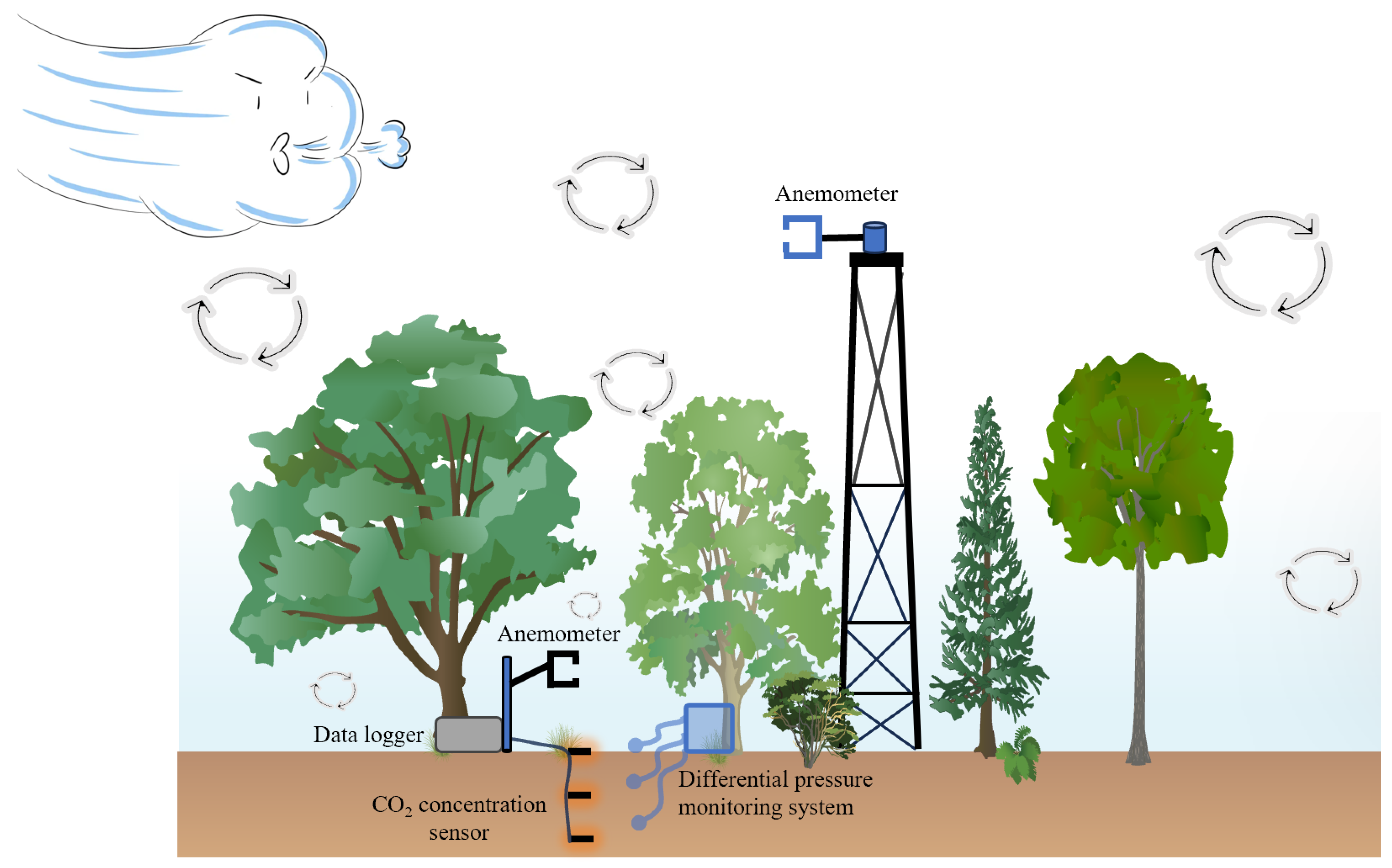
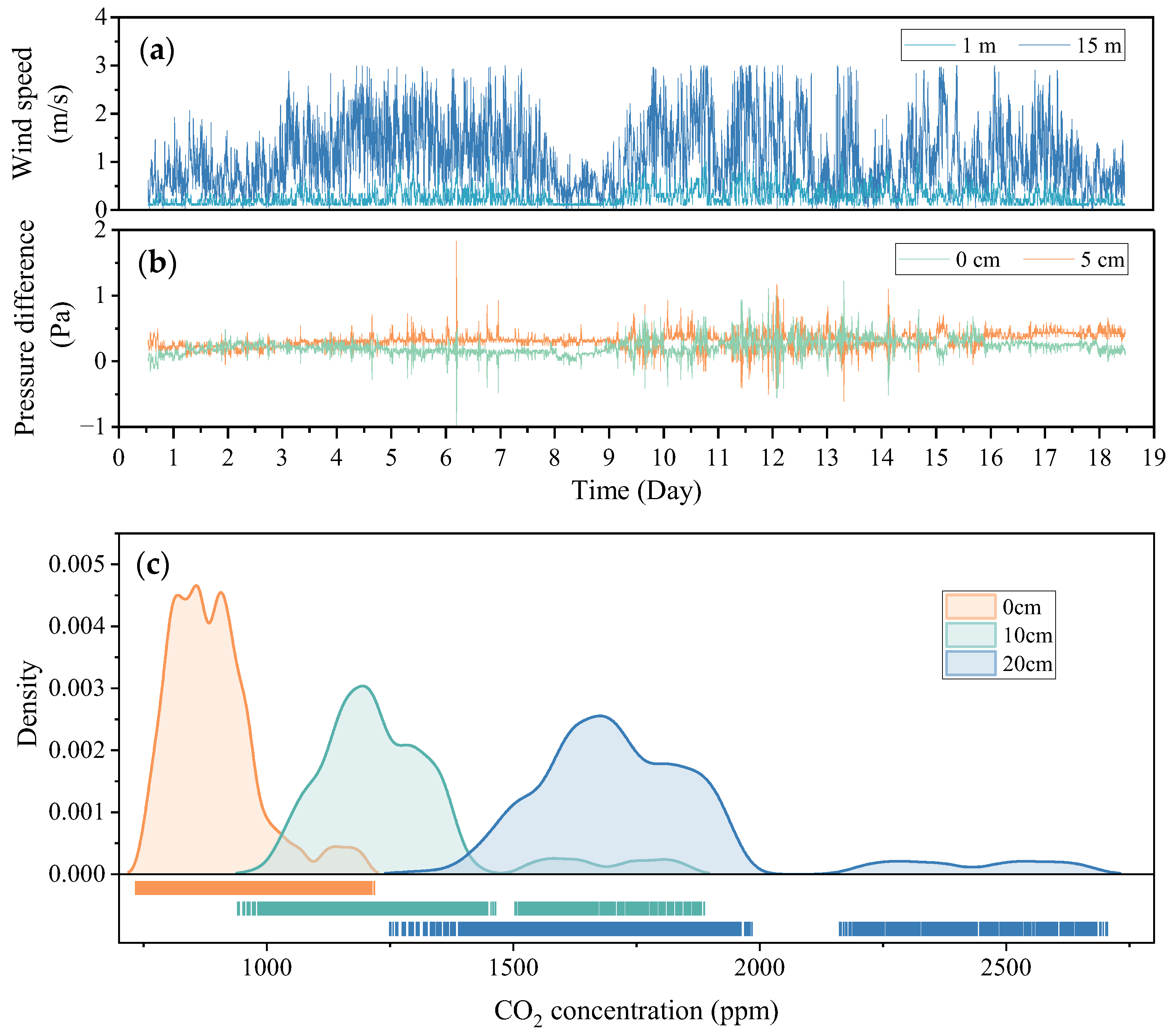
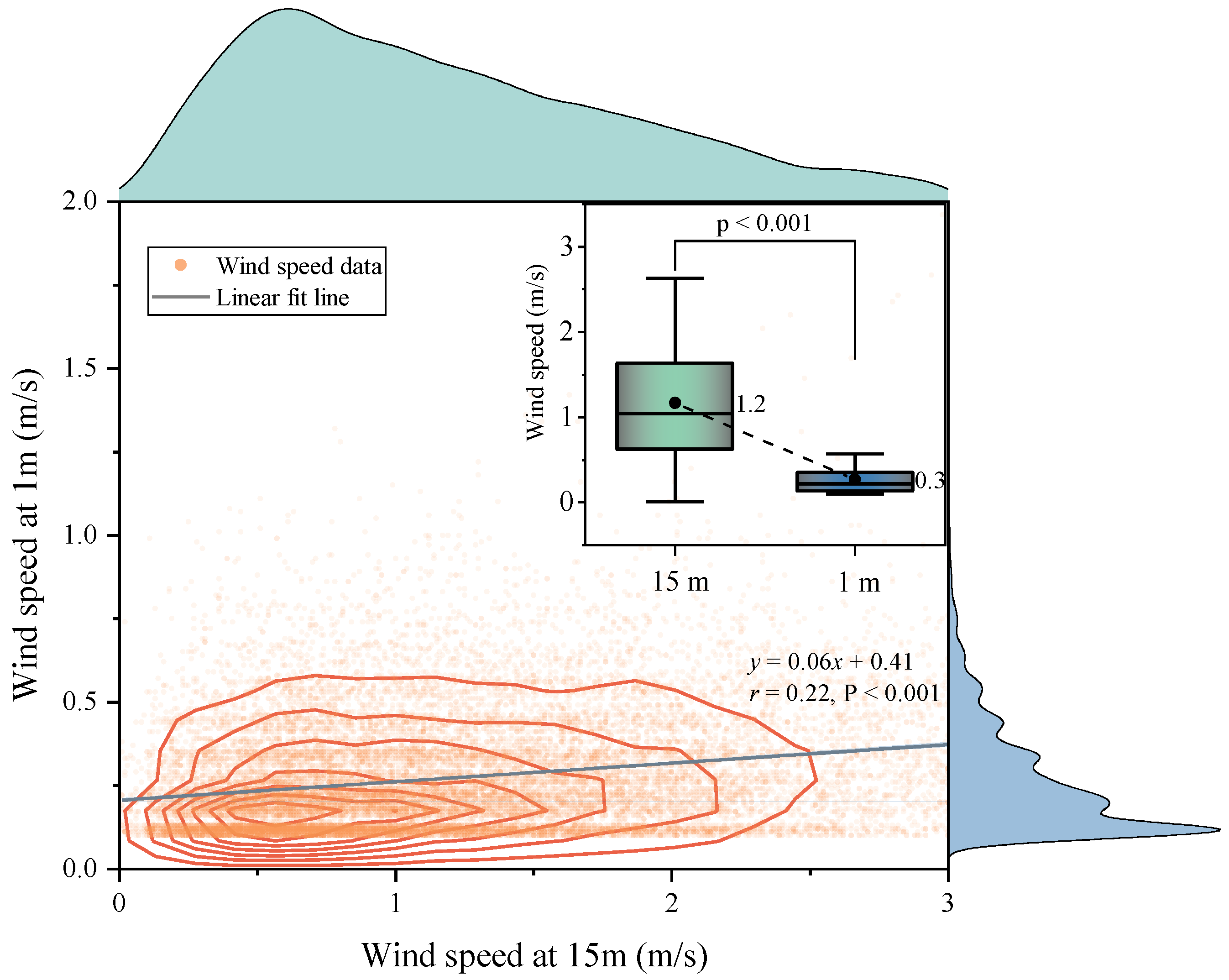
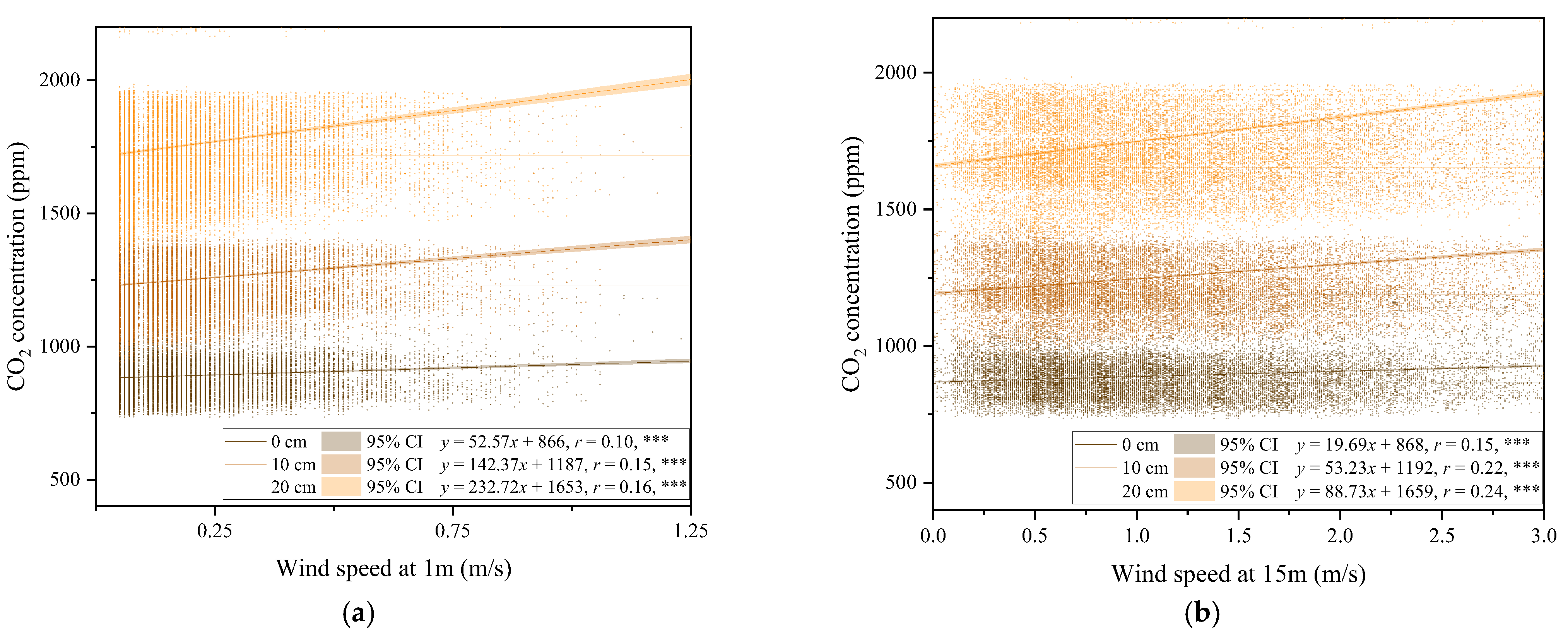
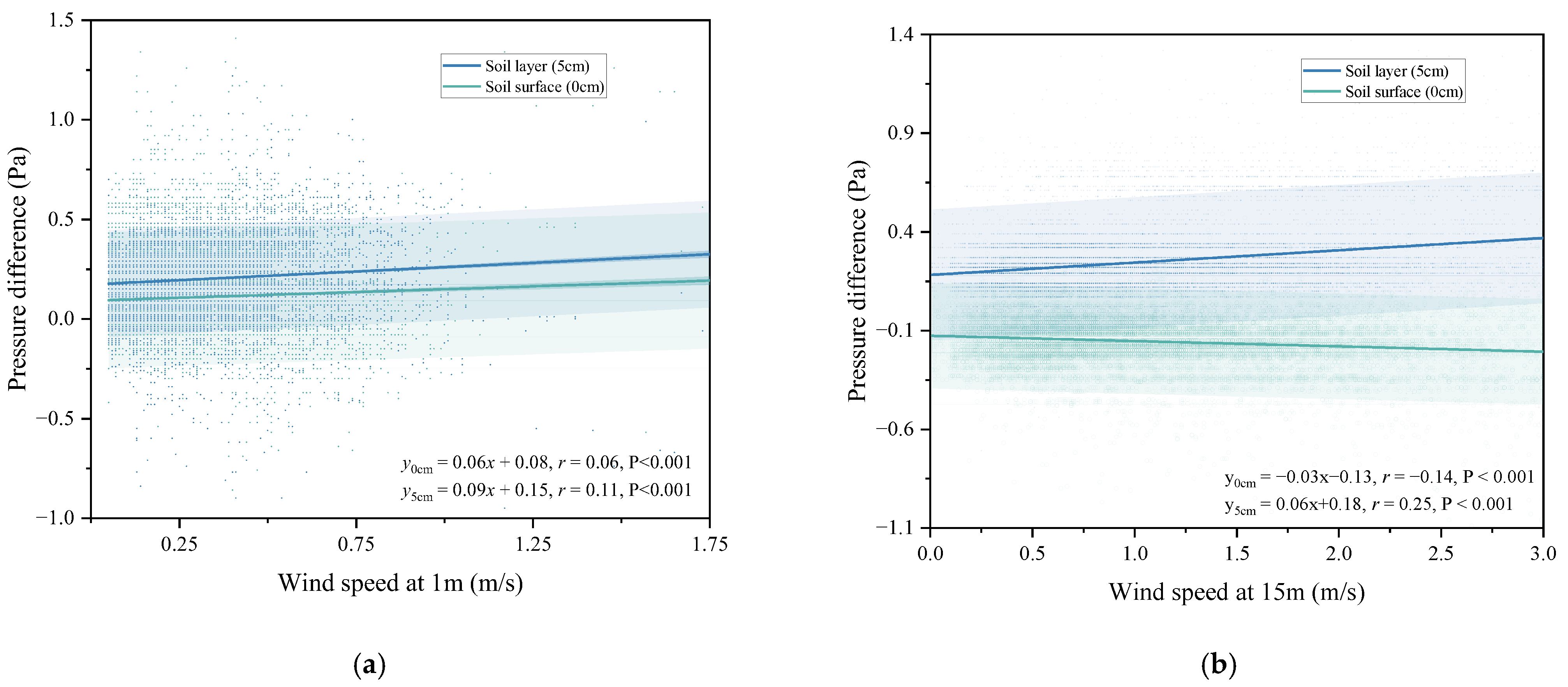

Disclaimer/Publisher’s Note: The statements, opinions and data contained in all publications are solely those of the individual author(s) and contributor(s) and not of MDPI and/or the editor(s). MDPI and/or the editor(s) disclaim responsibility for any injury to people or property resulting from any ideas, methods, instructions or products referred to in the content. |
© 2025 by the authors. Licensee MDPI, Basel, Switzerland. This article is an open access article distributed under the terms and conditions of the Creative Commons Attribution (CC BY) license (https://creativecommons.org/licenses/by/4.0/).
Share and Cite
Chen, T.; Jiang, J.; Feng, L.; Hu, J.; Liu, Y. Canopy-Wind-Induced Pressure Fluctuations Drive Soil CO2 Transport in Forest Ecosystems. Forests 2025, 16, 1637. https://doi.org/10.3390/f16111637
Chen T, Jiang J, Feng L, Hu J, Liu Y. Canopy-Wind-Induced Pressure Fluctuations Drive Soil CO2 Transport in Forest Ecosystems. Forests. 2025; 16(11):1637. https://doi.org/10.3390/f16111637
Chicago/Turabian StyleChen, Taolve, Junjie Jiang, Lingxia Feng, Junguo Hu, and Yixi Liu. 2025. "Canopy-Wind-Induced Pressure Fluctuations Drive Soil CO2 Transport in Forest Ecosystems" Forests 16, no. 11: 1637. https://doi.org/10.3390/f16111637
APA StyleChen, T., Jiang, J., Feng, L., Hu, J., & Liu, Y. (2025). Canopy-Wind-Induced Pressure Fluctuations Drive Soil CO2 Transport in Forest Ecosystems. Forests, 16(11), 1637. https://doi.org/10.3390/f16111637





